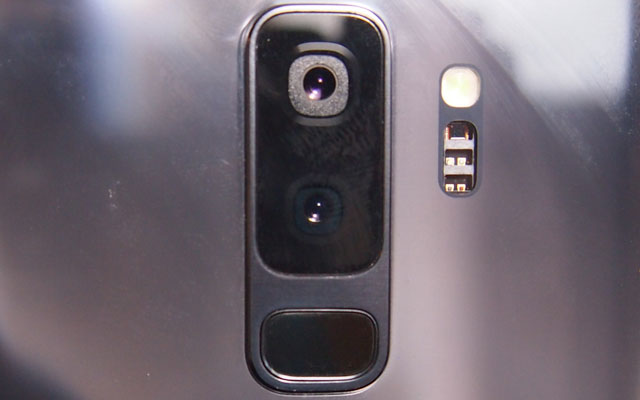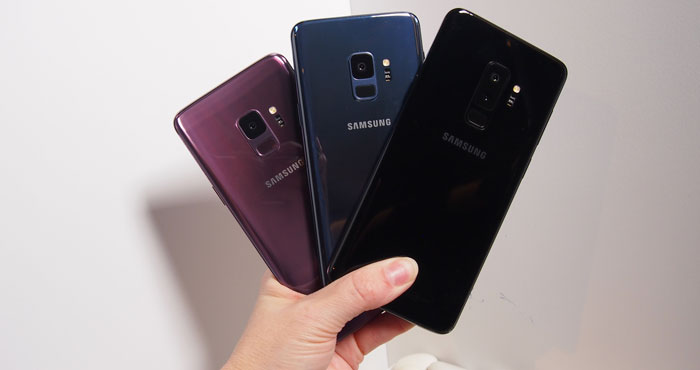With the successful launch of the Galaxy Note 8 under its belt, Samsung has regained the good graces of the Samsung-loving public. And with the Samsung Galaxy S9 and S9+, fans won't be disappointed. The new camera is a step up, but that's where the innovation stops. The rest of the Galaxy S9 and S9+ are largely the same as the S8 and S8+. Is it enough? For the Samsung Galaxy S6 or S7 owner, absolutely. For the Galaxy S8 owner, not so much. Here's what to expect.
Look and Feel
Like the Galaxy 5.8-inch S8 and 6.2-inch S8+, the Galaxy the S9 and S9+ are visually stunning. They share the same displays, but Samsung was able to reduce the bezel at the top and bottom, making them a little shorter and enhancing the sense that the front is all display.
The Quad HD+ displays on both devices have 290 x 1440 pixels, resulting in 570 ppi for the 5.8-inch S9 and 529 ppi for the 6.2-inch S9+. With an 18.5:9 aspect ratio, they're tall and narrow which means that even in my fairly small hands, I can easily use both phones with one hand. The HDR displays support HDR 10 content.
The S9 measures 147.7 x 68.7 x 8.5 mm, while the S9+ measures 158.1 x 73.8 x 8.5. That makes the S9 slightly shorter, wider and thicker than the Galaxy S8. The additional thickness is due to the fact that Samsung is using a new aluminum alloy and thicker glass on the front, which Samsung says will make the S9 models more rugged than the S8 models.
These phones are sleek. A volume rocker and a button dedicated to Samsung's voice-based Bixby assistant are on the left of the device, and the power button is on the right. There's also a fingerprint reader on the back and a slot that holds both the SIM and a microSD card.
Both phones are water-resistant with an IP68 rating, meaning they can easily withstand a dunk in the sink and be washed off if they get dirty.
The phones will come in Midnight Black, Coral Blue and Lilac Purple for the U.S. market.
New Dual-Aperture Camera
The big news for the Galaxy S9 and S9+ is their new Dual Aperture cameras with onboard processors and memory. The Dual Aperture means that the lens opening physically opens wider when there less light, enabling you to capture more detail and color in low light situations. The cameras automatically range from f1/5 - f/2.4, or you can manually adjust the aperture. The S9 has a single-lens 12MP camera with optical image stabilization and an 8MP f/1.7 front camera. The S9+ gets a dual 12MP cameras with dual optical image stabilization. The wide-angle camera has the f/1.5-2.4 dual aperture and the telephoto camera is a fixed f/2.4. The S9+ has an 8MP f/1.7 front camera, like the S9.

Samsung has added a Super Slow-mo mode, which stretches .2 seconds of video into a six-second clip. That means the camera is capturing 960 frames per second, up from the slow-mo mode on the S8 and S8+that captures 250 frames per second.
With the front cameras, you can take a selfie and turn it into an AR Emoji that looks like you. That extra processing power on the camera lets it take your 2D images and map out more than 100 facial features to create a 3D model that reflects your facial expressions in real time. The AR Emoji use a standard format so you can share them across most messaging platforms.

Samsung has upgraded the Bixby features of the camera, to add automatic translations in images with text, one-click shopping through retailers like Nordstrom when you see something you like and a makeup mode, which lets you try on makeup and then purchase products through retailers, including Sephora.
Security
Like the Galaxy S8 and S8+, the S9 and S9+ will use facial recognition, fingerprint scanning and iris recognition for security and unlocking your device. The security for facial scanning isn't considered robust enough for purchases with Samsung Pay and other high-security applications — you'll need iris recognition or fingerprint scanning for that — but face unlock could easily replace your passcode.
Battery Life and Charging
The Galaxy S9 and S9+ use the same capacity batteries as the S8 and S8+, a 3000mAh battery for the Galaxy S9 and a 3500mAh for the Galaxy S9+. Both support quick charging, which provides a half charge in half an hour. Both devices support wireless quick charging.
Performance
Both phones use Qualcomm 845 Snapdragon processors (in the U.S.). The Galaxy S9 comes with 4GB RAM and 64GB of storage and the S9+ has 6GB RAM and 64GB of storage. They'll be loaded with Android 8.0 Oreo.
Audio performance
Samsung added a second speaker to the Galaxy S9 and S9+ for rich stereo sound. Both phones also support Dolby Atmos for a rich, virtual 3D sound experience. It's not just a gimmick: the difference between the S9/S9+ and the S8/S8+ is noticeable.
Availability and Pricing

The Samsung Galaxy S9 and S9+ will be available for pre-order starting March 2, 2018, and the phones will be available starting March 16, 2018. Pre-order customers can save up to $350 with a qualifying trade-in, to be determined by the retailer. For instance, Verizon is offering $350 for the iPhone X, 8, 8 Plus and the Samsung Galaxy S8, 8+ and Note8. And, you'll get $300 for an iPhone 7, 7 Plus, 6S, 6SPlus; the Google Pixel, Pixel XL, Pixel 2, Pixels 2 XL, Motorola: Z2 Force, Z Force; and the Samsung: GS7, GS7 Edge, GS7 Active.
From Sprint, the Galaxy S9 will be available for $33 per month ($792) and the S9+ for $38 per month ($912). Verizon will be offering the Galaxy S9 for $33.33 per month for 24 months ($799.99) and the S9+ for $38.74 ($929.99).
[Image credit: Techlicious, Samsung]















From wendell on February 27, 2018 :: 12:49 pm
I’ve never owned a smart phone and when you say the sprint and verizon costs are so much a month is that just the service package for calls and internet?
I would like to get a smart phone to enhance my hobby of metal detecting and add maps and items like a small camera I can insert into walls that will plug into the smart phone.
Reply
From Josh Kirschner on February 27, 2018 :: 2:57 pm
The costs in the story are for the phone itself, not the monthly service. You would still need a monthly service plan on top of that for calls and data.
I’m not entirely clear what you’re looking for with the camera. The smartphone has its own camera, so no need to plug another camera into it. If you mean remotely connecting to a wall-mounted camera from an app on your smartphone, that’s very doable. We actually just did a roundup of the best security cameras: https://www.techlicious.com/review/the-best-home-security-camera/
Reply
From wendell on March 01, 2018 :: 12:49 pm
I meant endoscope camera that I can use to get inside places and see what is behind or inside tight places where a normal camera would not be able to access. It is supposed to plug into a smart phone. Instead of the expense of having a separate inspection camera and viewer, the endoscope can plug into the existing smart phone and keep my little hobby affordable. thanks, josh.
Reply